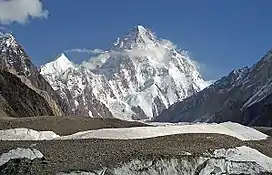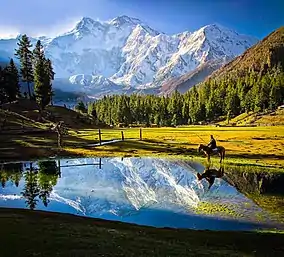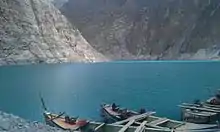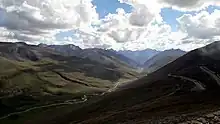
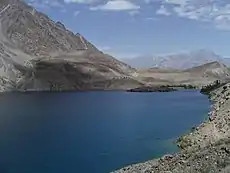
Tourism in Gilgit-Baltistan, an administered territory of Pakistan, focuses on its access to various mountain ranges and alpine terrain.
Geography
Gilgit-Baltistan borders Pakistan's Khyber Pakhtunkhwa Province to the west, a small portion of the Wakhan Corridor of Afghanistan to the north, Xinjiang, China to the northeast, the Indian territory Jammu and Kashmir and Ladakh to the southeast, and the Pakistani-administered state of Azad Kashmir to the south.
Gilgit-Baltistan is home to five of the "eight-thousanders" and to more than fifty peaks above 7,000 metres (23,000 ft). GilgitAstore and Skardu are the three main hubs for expeditions to those mountains. The region is home to some of the world's highest mountain ranges. The main ranges are the Karakoram and the western Himalayas. The Pamir Mountains are to the north, and the Hindu Kush lies to the west. Amongst the highest mountains are K2 (Mount Godwin-Austen) and Nanga Parbat, the latter being one of the most feared mountains in the world.
Three of the world's longest glaciers outside the polar regions are found in Gilgit-Baltistan: the Biafo Glacier, the Baltoro Glacier, and the Batura Glacier. There are, in addition, several high-altitude lakes in Gilgit-Baltistan.
Karakoram Highway
The Karakoram Highway is the major highway of Gilgit-Baltistan, which connects the region with the rest of Pakistan to the south and with China at its north end. It is highest paved road in world is sometimes termed as the "8th Wonder of World."[1]
Major valleys
Gilgit Baltistan is home of world highest and beautiful valleys. These include Ghanche, Shiger, Astore Valley, Gilgit, Ghizer Valley, Hunza Valley, Skardu and Nagar Valley.
Hunza Valley
Hunza Valley is considered one of the most beautiful valleys of Gilgit-Baltistan. It consists of Upper Hunza, Central Hunza, and Lower Hunza. Karimabad is the major city of the valley and has all facilities for mountaineers and tourists.[2] The popularity of the Hunza Valley and the amount of tourism there is due in part to its relative accessibility and proximity to the Karakoram Highway.[3]
Major tourist attractions in Hunza are:
- Attabad Lake - A major lake of Hunza Valley. It was created following a landslide at Hunza River near Attabad village on 4 January 2010. The resulting damming of the river caused the lake to slowly form, submerging several villages and displacing up to 6,000 people.[4]
- Baltit Fort - An old medieval fort located in Karimabad. It is also a UNESCO World Heritage Site.[5]
- Hussaini Suspension Bridge - A long wooden suspension bridge over Hunza River near Husaaini village. It is sometimes referred locally to as the "Indiana Jones Bridge" It is termed as one of the most dangerous bridges in the world.[6]
- Khunjerab Pass - At 4,693 meters, this is the highest border crossing in the world. It is also the only modern crossing on the China-Pakistan border. Most tourists visit on a daytrip from Hunza to see the border and then leave. The surrounding area is also a part of the Khunjerab National Park, which was set up to protect local, endangered wildlife, specifically the Marco Polo sheep.[7]
Skardu Valley
Skardu Valley is located at confluence of Indus and Shiger rivers surrounded by the peaks of Karakoram.
Lakes
- Sheosar tso Lake in Deosai National Park, Skardu
- Satpara tso Lake in Skardu, Baltistan
- Katzura tso Lake in Skardu, Baltistan
- Katpana tso Lake in Skardu, Baltistan
- Zharba Tso Lake in Shigar, Baltistan
- Phoroq Tso Lake in Skardu, Baltistan
- Lake Kharfak tso in Gangche, Baltistan
- Sozgung tso Lake in Thalay Valley, Baltistan
- Byarsa Tso Lake in Gultari, Baltistan
- Borith Lake in Gojal, upper Hunza, Gilgit
- Rama sar Lake near Astore
- Rush sar Lake near Nagar, Gilgit
- Karambar sar Lake at Kromber Pass Ishkoman Valley, Ghizer
- Barodaroksh Lake in Bar Valley, Nagar
- Ghorashi Lake in Ghandus Valley, Kharmang
- Attabad Lake, Hunza
- Khalti Lake, Gupis-Yasin District
Mountains
Eight-thousanders
K2 (Mount Godwin Austin/Chogori)
Nanga Parbat
Gasherbrum l
Broad Peak
Gasherbrum ll
Seven-thousanders
Gasherbrum lll
Gasherbrum lV
Masherbrum (K1)
Rakaposhi
Saltoro Kangri (K10)
See also
References
- ↑ Desk, Interactive (20 March 2016). "Karakoram Highway - the mighty 'eighth wonder of the world'". DAWN.COM. Retrieved 3 April 2021.
- ↑ "Places to visit in Gilgit Baltistan". Retrieved 30 March 2021.
- ↑ "Backpacking Pakistan | The COMPLETE Guide". The Broke Backpacker. 23 July 2016. Retrieved 3 April 2021.
- ↑ "Landslide Lake in Northwest Pakistan". earthobservatory.nasa.gov. 18 March 2010. Retrieved 3 April 2021.
- ↑ "Baltit Fort". UNESCO World Heritage Centre. Retrieved 3 April 2021.
- ↑ "By a Thread". National Geographic. Archived from the original on 15 April 2021. Retrieved 3 April 2021.
- ↑ Qureshi, Rahmatullah (1 April 2011). "First report on the biodiversity of Khunjerab National Park, Pakistan". Pakistan Journal of Botany. 43(2):849-861: 849.
